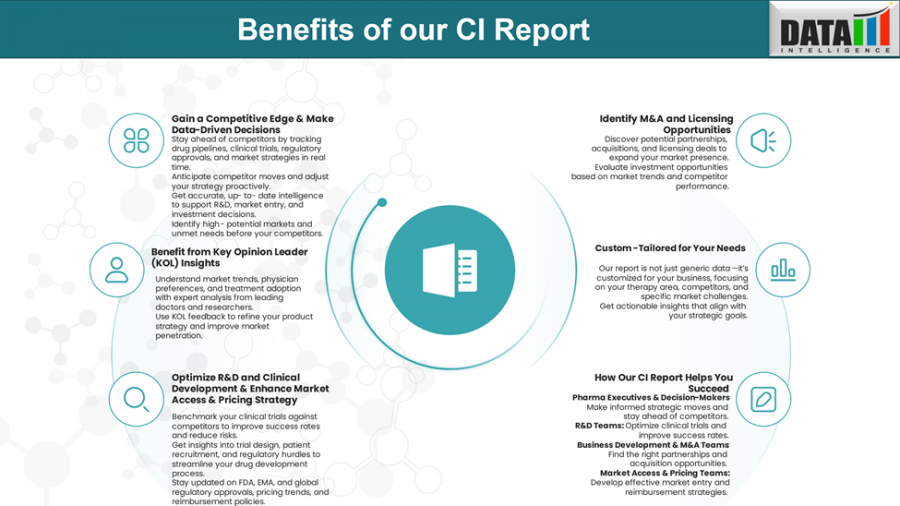
Hereditary Angioedema (HAE): Competitive Intelligence Insight into Next-Gen Treatment Strategies | DataM Intelligence
HAE care evolving with tailored prophylaxis, long-acting biologics, & gene therapies offering better disease control, fewer attacks, & improved quality of life
AUSTIN, TX, UNITED STATES, July 2, 2025 /EINPresswire.com/ -- Hereditary Angioedema (HAE) is a rare genetic disorder marked by sudden, severe swelling episodes in the skin, gut, or airway. Driven by C1-inhibitor deficiency or function dysfunction (types I and II) or rare factor XII mutations (type III), HAE causes unpredictable angioedema exacerbations that can be life-threatening. Traditional acute care and prophylactic regimens have been life-sustaining, but ongoing innovation now promises long-term attack prevention and even curative potential.
Download CI Sample Report: https://www.datamintelligence.com/strategic-insights/ci/hereditary-angioedema-hae
🌍 Epidemiology & Clinical Impact
HAE affects approximately 1 in 50,000 individuals globally. Symptoms typically begin in childhood or adolescence and persist throughout life. Swelling attacks can impair quality of life, cause hospitalizations, and pose fatal airway risks. Comorbidities like psychological burden and impaired daily functioning underscore the need for more effective, convenient care.
Estranged by frequent injections and therapy burden, patients often experience anxiety about attack unpredictability and treatment access—making new treatment strategies a critical need.
💊 Established Treatments: Pillars and Limitations
Acute Therapy
- Plasma-purified or recombinant C1-inhibitor replacement, icatibant (bradykinin receptor antagonist), and ecallantide (plasma kallikrein inhibitor) have enabled rapid attack relief.
- While effective, on-demand therapy does not prevent attacks and often requires travel or emergency care.
Prophylactic Options
- Intravenous C1-inhibitor (e.g., Cinryze®) administered every 3–4 days reduces attack frequency but requires venous access.
- Subcutaneous lanadelumab (plasma kallikrein inhibitor) provides monthly dosing with excellent prophylaxis.
- Berotralstat (oral kallikrein inhibitor) and subcutaneous C1-inhibitor alternatives offer daily or weekly self-administered options.
- Despite advances, access, dosing fatigue, and cost remain barriers for widespread adoption.
🔬 Emerging Pipeline & Strategic Innovation
The evolving HAE landscape is defined by convenience, novel mechanisms, and longer-acting formats:
Once-Weekly/Monthly Biologics
- Next-generation subcutaneous C1-inhibitors, in development, aim for once-weekly dosing while maintaining effective C4 and kallikrein control.
- Enhanced half-life kallikrein inhibitors, including monoclonal antibodies or fusion proteins, could extend dosing frequency to once monthly or quarterly.
Oral and Inhaled Small Molecules
- Oral kallikrein inhibitors with improved pharmacokinetics and lower drug interaction potential are in Phase II/III trials.
- Inhaled bradykinin modulators or kallikrein-blockers are being explored to offer rapid, convenient airway-targeted prophylaxis.
Gene and Cell Therapy—Toward the Cure
- AAV-mediated C1-inhibitor gene therapy is progressing in early clinical trials to provide long-term protein correction with a single injection.
- CRISPR-based gene editing targeting C1-inhibitor gene could permanently correct the genetic defect; early preclinical results are promising but still nascent.
- Cell-based approaches, including engineered hepatocytes or stem cell grafting, aim to deliver C1-INH from a stable cellular depot.
Book Free CI Consultation Call: https://www.datamintelligence.com/strategic-insights/ci/hereditary-angioedema-hae
🧠 Competitive Landscape & Class Positioning
C1‑Inhibitors vs Kallikrein Inhibitors
- C1-INH products replace the missing protein and restore complement cascade control, offering physiological correction.
- Kallikrein inhibitors (lanadelumab, berotralstat) target downstream bradykinin activation—often with less immunogenicity but without fully restoring complement regulation.
Route & Dosing Differentiation
- Intravenous use enables immediate effect but burdens patients with repeated access.
- Subcutaneous administration empowers patient-controlled care; brand expansion will rely on dosing frequency and pharmacodynamic profile.
- Oral prophylactics improve compliance—dependent on safety and efficacy at lower systemic exposure.
Cutting-Edge Gene-Based Solutions
- Gene therapy offers a potential one-time, lifelong fix—if durability and safety hold true.
- Gene editing implies curative intent but carries long-term risk considerations. Its emergence may relegate chronic prophylaxis to last resort.
Ask for Customized Sample Report as per your Business Requirement: https://www.datamintelligence.com/strategic-insights/ci/hereditary-angioedema-hae
🎯 Target Opportunity Profile
For maximum competitive edge, emerging HAE therapies should achieve:
- High Effectiveness: ≥90% reduction in swelling attacks vs baseline.
- Convenient Dosing: Oral daily, subcutaneous weekly or monthly, or one-time gene therapy with lasting effect.
- Strong Safety Profile: Low immunogenicity, minimal bleeding risk, and liver/renal safety.
- Mechanistic Innovation: Genetic correction, extended half-life biologics, or convenient oral routes.
- Patient-Centric Design: Ease of use, self-administration, and minimal monitoring burden.
- Durability & Durability Evidence: Long-term data on attack control and health economics to support access.
🗓 2025–2028 Outlook
- Phase III results for long‑acting subcutaneous biologics could expand monthly dosing convenience.
- Gene therapy programs may report early durability and safety data, signaling a shift to one‑time correction.
- Oral prophylactics could challenge injectables if daily dosing results in comparable attack rates.
- Market access and reimbursement will hinge on demonstrating cost-effectiveness, especially against generics and extended-life biologics.
✅ Conclusion
Hereditary Angioedema is transitioning from episodic rescue care to long-lasting protection—and possibly a cure. Next-gen biologics, oral options, and gene-based corrections are altering the therapeutic landscape to focus on durability, personalization, and patient empowerment. As precision and convenience rise to the forefront, 2025 marks a pivotal moment in delivering better care and possibly ending the HAE cycle for good.
Read Related CI Reports:
1. Alpha 1 Antitrypsin Deficiency | Competitive Intelligence
2. Chronic Spontaneous Urticaria | Competitive Intelligence
Sai Kumar
DataM Intelligence 4market Research LLP
+1 877-441-4866
sai.k@datamintelligence.com
Visit us on social media:
LinkedIn
X
Distribution channels: Healthcare & Pharmaceuticals Industry
Legal Disclaimer:
EIN Presswire provides this news content "as is" without warranty of any kind. We do not accept any responsibility or liability for the accuracy, content, images, videos, licenses, completeness, legality, or reliability of the information contained in this article. If you have any complaints or copyright issues related to this article, kindly contact the author above.
Submit your press release
